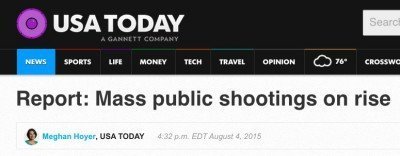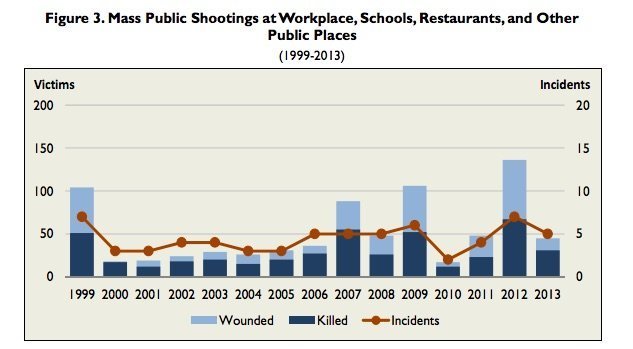Are mass shootings on the rise? Yes or no?!!!
That’s kinda how I feel about this subject. Just give me a straightforward answer to that question. A simple “yes” or a “no.” Of course things aren’t always that simple, especially when you’re talking about a subject matter that’s shrouded in controversy.
Let me start by addressing the question at hand, which has particular importance in the wake of a report, “Mass Murder with Firearms: Incidents and Victims, 1999-2013,” released last week by the Congressional Research Service.
The answer to the question is not in a statistically significant way. Still not clear? Well, there’s been a slight uptick in recent years, but certainly not a dramatic rise as some gun-control organizations would have one believe.
To quote criminologist James Alan Fox, who authored a book on the subject, “Extreme Killing: Understanding Serial and Mass Murder,” the report’s findings show “a great volatility in the numbers. There’s no solid trend.”
“No matter how you cut it, there’s no epidemic,” added the Northeastern professor in an interview with Reason.com. “This report should calm the fears that many people have that these numbers are out of control.”
To repeat, there is no epidemic!
Definitions Matter
One of the most vexing aspects of looking at mass shootings is that there is a lot of confusion about what certain terms mean. Specifically, how does one define “mass shooting,” or “mass murder” or “mass public shooting”? Are they all the same thing?
No, they’re not.
For purposes of clarity, the FBI doesn’t put mass shootings in a specific category. What the agency tracks is “mass murder,” which is defined as a single event in one location where four or more victims are slain (not including the perpetrator). The FBI doesn’t differentiate between mass murders with a knife versus a gun or a bat or any other implement.
However, for the purposes of the report, the CRS looked at FBI statistics (mass murders) as well as research gathered from various criminologists, including Fox, to devise definitions for mass shootings, mass public shootings, familicide mass shooting, and other felony mass shooting.
The CRS defined them thusly:
“mass shooting” means a multiple homicide incident in which four or more victims are murdered with firearms—not including the offender(s)—within one event, and in one or more locations in close geographical proximity;
“mass public shooting” means a multiple homicide incident in which four or more victims are murdered with firearms—not including the offender(s)—within one event, and at least some of the murders occurred in a public location or locations in close geographical proximity (e.g., a workplace, school, restaurant, or other public settings), and the murders are not attributable to any other underlying criminal activity or commonplace circumstance (armed robbery, criminal competition, insurance fraud, argument, or romantic triangle);
“familicide mass shooting” means a multiple homicide incident in which four or more victims are murdered with firearms—not including the offender(s)—within one event, and a majority of the victims were members of the offender’s immediate or extended family, the majority of whom were murdered in one or more private residences or secluded, sparsely populated settings in close geographical proximity, and the murders are not attributable to any other underlying criminal activity or commonplace circumstance (e.g., armed robbery, criminal competition, insurance fraud, argument, or romantic triangle); and
“other felony mass shooting” means a multiple victim homicide incident in which four or more victims are murdered with firearms—not including the offender(s)—within one event, in one or more locations in close geographical proximity, and the murders are attributable to some other underlying criminal activity or commonplace circumstance (e.g., armed robbery, criminal competition, insurance fraud, argument, or romantic triangle).
It’s a lot to digest, but it’s important to compare apples to apples when analyzing the data. CRS did a pretty good job of doing so, comparing apples to apples, in the report.
How Slight is the Uptick?
The reports essential findings are iterated in the graph below. Though the report is 46-pages long, this is basically what you need to know:
There are also several helpful graphs that give you a sense of just how small the uptick is (see below):
You’ll also note that there was a claim in the report about the increase in mass public shootings from the 1970s to today. But when adjusted for population growth, the per capita numbers of mass shooting each decade varies little, according to Fox who said, “Basically, there is no rise. There are some years that are bad, some that are not so bad.”

A look at the firearms murder rate per 100,000 population and the mass public shooting murder rate. You’ll note that the uptick in 2012 (due to Sandy Hook, Aurora) was a bit of an outlier, as noted in the findings listed above. (Photo: CRS)
Does Any of this Really Matter?
The short answer is no. Our right to keep and bear arms exists independent of crime rates, murder rates or trends in mass shootings.
Yet, there is a constant push by gun grabbers to use crime-related statistics to justify infringements on the Second Amendment. For the most part, these efforts have come up shot because there has been a uniform drop in property crime, violent crime and the overall homicide rate as gun rights, specifically the right to carry concealed, have been expanded over the past two decades.
At first glance, this latest study on mass shootings is ostensibly good news for anti-gunners. However, a quick examination shows once again that there is no substantive argument to make about any causal relationship between gun laws and mass shootings. Moreover, any claim that a certain gun-control bill will somehow reduce the number of mass shootings is equally unfounded as gun-control laws (the federal ban on Assault Weapons) have come and gone and the trend in mass shootings — about 21 per year — remains virtually unchanged.




P.S.: I left out one of the most important facts, though it has been mentioned above.
6. Many of the mass shootings are occurring in government created “victim zones,” where defensive weapons are banned. Our government does not even trust our military to carry and protect themselves, at a time when they are under grave threat on U.S. soil. You would have to be a complete idiot not to conclude that there is a government conspiracy to take away our 2nd Amendment Rights.
So, the statistics say perhaps a slight rise in mass shootings, with no trend detected. This tells us just about nothing.
Let’s look at important facts we do know:
1. Major international terrorist groups, such as ISIL, Boko Harram, Haqqani Network, and others have vowed and carried out mass shootings on U.S. soil, and on our allied nations.
2. Every week gang bangers attempt/carry thru with mass shooting in Chicago, Baltimore, and other U.S. cities.
3. At a time when our Country is under grave threat from these groups we have gun grabbers and their sheeple trying to disarm the U.S.A.
4. There is still no major push to protect our children by providing armed guards at schools.
5. The only way to meet force is with force. Crime can happen in an instant, and the police are only minutes away.
Carry safely my friends.
You know, now that I think about it there have been a lot of mass shootings lately. But there has been an increase of businesses becoming “gun free zones.” I wonder if there’s some connection between the two. But what do I know? I’m a gun enthusiast so of course I’m bias and can’t read facts. Like how the crime rate in kennesaw, Georgia dropped after the mayor required home owners to have a fire arm in their houses. http://rense.com/general9/gunlaw.htm
There are several drivers of violence that could and should compared and correlated or not. The first being economics (unemployment assistance applications, CPI, and consumer debt), social (divorce rates, spousal and child abuse reports) and demographics (population density where the offender has resided for the past decade, average age of overall populations – violent crimes are generally crimes of younger people – and to be scientific – if not PC you should include ethnicity of the offender, but adjusted with their state of racial/culture – immersion/isolation as measurement of integration into the dominant local population’s culture and ethnicity.)
All of these suggestions are admittedly academic and aren’t likely to offer a solution to any kind to violence – firearms or otherwise, but it would increase our understanding of the process that initiates the mental conditions that lead to mass violence. To blame the tools of violence is simple minded and intellectually lazy if not fraudulent.
Today’s news added to the death toll of the explosions in China from an incompetently managed waste storage and disposal facility. The number the last I saw was 113 people dead and many more injured. Disregarding the different locations – are these people less dead from incompetence, greed and laziness than they would have been from our lazy and incompetent management of mental illness’s desperation, confusion, rage, and or emotional isolation? We as a nation preoccupy ourselves with the symptoms and artifacts of problems and not the sources of the problems. Additionally, our expectations of a perfect society are just as naive – as they are practically unrealizable.
i think the world can lay the blame for all these atrocities at the feet of obama. my guess if someone would/could dig deep enough you would find ties to the white house residents at this moment in time.
any takers?
remember he said he would help the moslims when the time came.
So its ok that we compare ourselves to Iraq, Iran and Afghanistan and lose? We need a better argument than that. Where I live I can have all the guns I want but I can’t burn my own garden waste because fire is dangerous. I see the wheel on the endangered species list if this continues.
Compared with other civilized countries with heavy gun restrictions our record sucks. At the range I see poor and dangerous handling all the time which suggests parents generally aren’t teaching good practice. Maybe we could sway opinion better if we policed ourselves more rigorously. Though going up to an armed moron and telling him he’s being foolish might not be an ideal solution. Any ideas anybody?
To see the overall picture of what the gun banners are attempting to blame on gun ownership, it is also helpful to view global statistics on homicides of all kinds–particularly in countries where it is not lawful for a common citizen to possess a firearm:
http://chartsbin.com/view/1454 (here’s a good place to start)
Statistically, the U.S. is well below the worldwide average on homicides per 100,000–actually an appalling contradiction in view of the the fact that in the US there are enough firearms to arm every man, woman and child who lawfully lives here. Certainly, if guns contributed to crime in any way, the population would have been drastically reduced long ago. Apparently, the tool used has little bearing on the statistics.
Interesting and useful chart in-so-far as the data is reliable. Thanks. Developed countries with some form of elected governments and the necessary resources (economic and technical) probably have meaningful statistics on violence. Countries where the govs. only use stats to support their own agendas and where the governments are responsible for much of the violence ( like China, much of ME, Africa and SA) have stats that are extremely questionable at best, and at worst simply confuse the data comparisons with countries accurately reporting.
A useful chart for comparison would be that of mass murders perpetrated with a weapon other than a firearm.